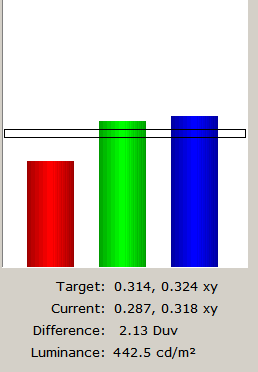Syntax Olevia 30" LCD: Cheap, Robust and Exceptional
by Kristopher Kubicki on June 30, 2004 12:00 AM EST- Posted in
- Displays
ColorVision Spyder
Before running DisplayMate and our subjective analysis of the LCD, we ran ColorVision's Spyder and OptiCal software. Not only does this calibrate the monitor accurately on the DVI and analog interface, but it also gives us specific luminescence information not obtainable through subjective analysis. Special thanks to our friends at ColorVision for providing us with both a ColorVision Spyder and their OptiCal software.Our test bed uses a Radeon 9800 XT video card. We use the factory included DVI cable for this portion of the benchmark. Resolutions are on the native 1280x768.
And here is what our Spyder and OptiCal software have to say:

As far as LCDs go, the Syntax LT-30 was calibrated very well before we ran our ColorVision analysis. Curves appeared tighter on the Olevia unit even though the Albatron uses a nearly identical panel.










21 Comments
View All Comments
Swaid - Thursday, July 1, 2004 - link
K, got it...what I found from Digital Display Work Group (www.ddwg.org)
Dual Link
Dual Link DVI supports 2x165 MHz (2048x1536 at 60 Hz, 1920x1080 at 85 Hz). A dual link implementation utilizes all 24 of the available pins.
Single Link
Single Link DVI supports a maximum bandwidth of 165 MHz (1920x1080 at 60 Hz, 1280x1024 at 85Hz). A single link implementation utilizes 12 of the 24 available pins.
Souka - Thursday, July 1, 2004 - link
1280x768 native? Too low rez...my 19" is at that rez.TallCoolOne - Thursday, July 1, 2004 - link
Apple Dual-Link version of the nVidia 6800 is also exclusive to the PowerMac G5, so there's another $2000 or so needed to run the Apple 30"....I'm sure this technology will come to the PC _very_ soon, and will also require serious video card muscle to run at such high resolutions. For that reason, I don't see the same requirement on a Mac as a fair basis of criticism.
PrinceGaz - Thursday, July 1, 2004 - link
#14- the Apple display requires a Dual-Link DVI connection because Single-Link DVI isn't capable of a 2560x1600 resolution.Single-Link DVI only has 165MHz bandwidth which means a maximum resolution of 1920x1080 or 1600x1280 at a refresh-rate of 60hz. By using Dual-Link you get double the bandwidth which allows for double the resolution -- 2560x1600 is exactly double 1600x1280.
Neekotin - Thursday, July 1, 2004 - link
hey kris, is it really that good? ive been shopping for the dell 20' lately and now this.. your making my headache..Swaid - Thursday, July 1, 2004 - link
#15Awsome!
KristopherKubicki - Thursday, July 1, 2004 - link
Working on the Apple LCD and the Philips 1920x1080 LCD also.Kristopher
Swaid - Wednesday, June 30, 2004 - link
Has anyone seen reviews of the 30" Apple LCD display yet? The claimed 16ms response times sound very interesting for a 30" LCD...Actually it sounds like its 2 LCD panels put together since it needs a card capable of dual DVI output... Interesting!
Anandtech needs to review this ASAP! :D
WileCoyote - Wednesday, June 30, 2004 - link
Wow, it's a LCD review and the manufacturer isn't Samsung! Remember this moment, they don't come very often at Anandtech.Dagar - Wednesday, June 30, 2004 - link
Does the TV supply EDID to the PC via DVI?